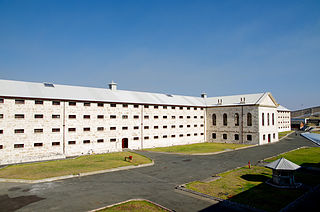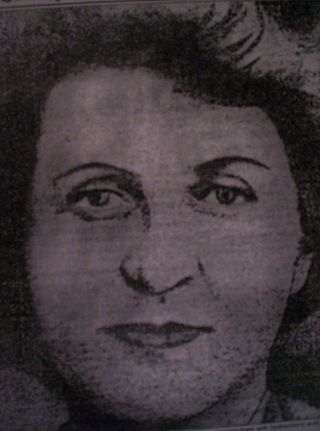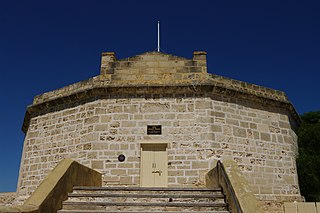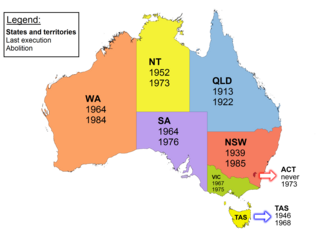
Tyburn was a manor (estate) in the county of Middlesex, England, one of two which were served by the parish of Marylebone. Tyburn took its name from the Tyburn Brook, a tributary of the River Westbourne. The name Tyburn, from Teo Bourne, means 'boundary stream'.

Charles Yelverton O'Connor,, was an Irish engineer who is best known for his work in Western Australia, especially the construction of Fremantle Harbour, thought to be impossible, and the Goldfields Water Supply Scheme.

Capital punishment in the United Kingdom predates the formation of the UK, having been used within the British Isles from ancient times until the second half of the 20th century. The last executions in the United Kingdom were by hanging, and took place in 1964; capital punishment for murder was suspended in 1965 and finally abolished in 1969. Although unused, the death penalty remained a legally defined punishment for certain offences such as treason until it was completely abolished in 1998; the last execution for treason took place in 1946. In 2004, Protocol No. 13 to the European Convention on Human Rights became binding on the United Kingdom; it prohibits the restoration of the death penalty as long as the UK is a party to the convention.

The Old Melbourne Gaol is a former jail and current museum on Russell Street, in Melbourne, Victoria, Australia. It consists of a bluestone building and courtyard, and is located next to the old City Police Watch House and City Courts buildings, and opposite the Russell Street Police Headquarters. It was first constructed starting in 1839, and during its operation as a prison between 1845 and 1924, it held and executed some of Australia's most notorious criminals, including bushranger Ned Kelly and serial killer Frederick Bailey Deeming. In total, 133 people were executed by hanging. Though it was used briefly during World War II, it formally ceased operating as a prison in 1924; with parts of the jail being incorporated into the RMIT University, and the rest becoming a museum.

Capital punishment – the process of sentencing convicted offenders to death for the most serious crimes and carrying out that sentence, as ordered by a legal system – first appeared in New Zealand in a codified form when New Zealand became a British colony in 1840. It was first carried out with a public hanging in Victoria Street, Auckland in 1842, while the last execution occurred in 1957 at Mount Eden Prison, also in Auckland. In total, 85 people have been lawfully executed in New Zealand.

Fremantle Prison, sometimes referred to as Fremantle Gaol or Fremantle Jail, is a former Australian prison and World Heritage Site in Fremantle, Western Australia. The site includes the prison cellblocks, gatehouse, perimeter walls, cottages, and tunnels. It was initially used for convicts transported from Britain, but was transferred to the colonial government in 1886 for use for locally-sentenced prisoners. Royal Commissions were held in 1898 and 1911, and instigated some reform to the prison system, but significant changes did not begin until the 1960s. The government department in charge of the prison underwent several reorganisations in the 1970s and 1980s, but the culture of Fremantle Prison was resistant to change. Growing prisoner discontent culminated in a 1988 riot with guards taken hostage, and a fire that caused $1.8 million worth of damage. The prison closed in 1991, replaced by the new maximum-security Casuarina Prison.

The Don Jail was a jail in Toronto, Ontario, Canada, located to the east of the Don River, on Gerrard Street East in the Riverdale neighbourhood. The original building was completed in 1864 and was reopened in 2013 to serve as the administrative wing of Bridgepoint Active Healthcare, a rehabilitation hospital located adjacent to the jail. Prior to its adaptive reuse as part of a healthcare facility, the building was used as a provincial jail for remanded offenders and was officially known as the Toronto Jail. The jail originally had a capacity of 184 inmates, and it was separated into an east wing for the men and a west wing for the women.

Civil disturbances in Western Australia include race riots, prison riots, and religious conflicts – often Protestant versus Catholic groups.

Martha Rendell was the last woman to be hanged in Western Australia, for the murder of her de facto husband's son, Arthur Morris, in 1908. She was also suspected of killing his two daughters, Annie and Olive, by swabbing their throats with hydrochloric acid. Although the children died slow and agonizing deaths, they had been treated by a number of doctors during their illnesses, only one of whom expressed any doubts about their deaths.

The Round House was the first permanent building built in the Swan River Colony. Built in late 1830 and opened in 1831, it is the oldest building still standing in Western Australia.

The Perth Gaol was a gaol built in Perth, the state capital of Western Australia, between 1854 and 1856 to house convicts and other prisoners. It is located just west of Beaufort Street.

Capital punishment in Australia was a form of punishment in Australia that has been abolished in all jurisdictions. Queensland abolished the death penalty in 1922. Tasmania did the same in 1968. The Commonwealth abolished the death penalty in 1973, with application also in the Australian Capital Territory and the Northern Territory. Victoria did so in 1975, South Australia in 1976, and Western Australia in 1984. New South Wales abolished the death penalty for murder in 1955, and for all crimes in 1985. In 2010, the Commonwealth Parliament passed legislation prohibiting the re-establishment of capital punishment by any state or territory. Australian law prohibits the extradition or deportation of a prisoner to another jurisdiction if they could be sentenced to death for any crime.

William Calcraft was a 19th-century English hangman, one of the most prolific of British executioners. It is estimated in his 45-year career he carried out 450 executions. A cobbler by trade, Calcraft was initially recruited to flog juvenile offenders held in Newgate Prison. While selling meat pies on streets around the prison, Calcraft met the City of London's hangman, John Foxton.
Cyril Ayris is an author from Western Australia who has, after a long career in journalism, written books with both topical and historical subjects.

James Billington was a hangman for the British government from 1884 until 1901. He was the patriarch of the Billington family of executioners. Billington died at home from emphysema in the early hours of 13 December 1901, ten days after having executed Patrick McKenna, a man he knew well.
William Conroy was the last person executed at the Perth Gaol. Conroy was convicted of murdering Fremantle Town Councillor John Snook.
The history of Fremantle Prison, a former Australian prison in Fremantle, Western Australia, extends from its construction as a prison for convicts, using convict labour, in the 1850s, through to its modern-day usage as a tourist attraction. The design for Fremantle Prison was based on the Pentonville Prison in Britain, and it would be the longest, tallest prison cell block in the southern hemisphere. Construction began in 1851, and was completed by the end of 1859. The prison was transferred to the colonial government in 1886 for use for locally sentenced prisoners. Following a Royal Commission held in 1898−99, some changes were made to Fremantle Prison, including knocking down the inner wall between two cells, introducing a prisoner classification system, and constructing internal walls in the main block to create four separate divisions. A new cell block, New Division, was completed in 1907 and occupied in 1908.

The architecture of Fremantle Prison includes the six-hectare (15-acre) site of the former prison on The Terrace, Fremantle, in Western Australia. Limestone was quarried on-site during construction, and the south-western corner and eastern portion of the site are at a considerably higher ground level. The Fremantle Prison site includes the prison cell blocks, gatehouse, perimeter walls, cottages, tunnels, and related infrastructure.

Numerous riots and disturbances occurred at Fremantle Prison over its years of operation. Constructed in the 1850s using convict labor and modeled after Pentonville Gaol, Fremantle Prison served as Western Australia's primary maximum security facility for male offenders. Despite some reforms prompted by Royal Commissions in 1898−99 and 1911, substantial changes to the prison's operation didn't commence until the 1960s. Among the earliest incidents was one in 1854, while major riots took place in 1968 and 1988, causing significant damage to the prison.















